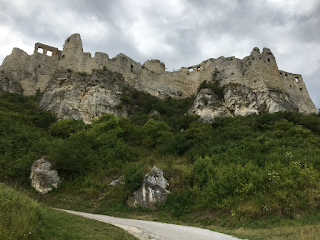To Riga (Latvia) - via the Beach
We set off after breakfast, driving south through Estonia towards Latvia. En route there’s a beach and spa resort town called Parnu and we spend time paddling in warm water amongst the holiday makers and families who flock here during the summer. The beach is pretty crowded but it has a nice vibe. A boardwalk takes you towards the sea, almost to the water’s edge. No surf here. The sand is cool and pale and soft and fine. After all the walking we’ve done on tour it’s nice to take our shoes off and feel sand between our toes. The water is warm and very shallow; you have to go out a long way to get wet.
The roads are straight and our bus driver wants to pass everything in front of him, even great big trucks. Even three great big trucks in a row. We lurch out and around any vehicle in front of us, sometimes cutting it reasonably fine. He’s an experienced driver and we’re in good hands but it’s still a little unnerving. There is some grimacing. Everyone is passing everyone, but not in the way we know it.
As the kilometres clock up, I come to understand the open road driving method here. It works brilliantly. Most of the highway between Tallin and Riga is just two lanes (one each way). There are no passing lanes, just a wide shoulder on each side. People tend to drive straddling this shoulder which gives room for cars to pass, either way, thereby effectively creating a passing lane anywhere on the road, except danger spots when passing is neither allowed nor sane - and there aren’t many of those as the roads are so straight. The traffic flows well and drivers are courteous, if not patient, negotiating the roads and lanes with ease. It works.
It’s compulsory to have your lights on when driving, 24/7, so this helps hugely in gauging distance and whether passing is wise or foolhardy.
This is a fabulous system but alas would be unworkable in NZ given the winding hills everywhere. We’re stuck with passing lanes, but the Baltic way is so much more efficient and effective.
As we approach Riga the traffic leaving town becomes horrendous. It’s Saturday and there is a big music festival on (which we passed earlier - tents and crowds of young people arriving and preparing), so the traffic could well be heading for that. There is no more passing possible, it’s bumper to bumper on the other side of the road.
Upon arrival in Riga, the largest of the three Baltic capitals, with its trams and trolley buses, we enjoy a delicious lunch in an elegant restaurant. Marianna then takes us for a guided walk around the Old Town. It is sweltering and we’re all melting under the hot afternoon sun. We pass the Dome Cathedral which has the largest organ in Europe - 10,000 pipes, the smallest being 10cm and the largest 10m long. It’s a charming town and we gather in the main square in front of the town hall, seeking shade. It’s stifling.
Riga is known for its art nouveau style, which became popular between the wars, and we walk along a street full of such buildings. As we enter a courtyard through a huge wrought iron gate, a ginger cat appears from nowhere, leaps past me in mid-air and just about gets himself squished as the gate closes. He manages to escape unscathed as I let out a yell.
In one building there is the most exquisite staircase.
We check into the Grand Poet Hotel and the evening is free. Some of us congregate in the bar for a beer and a light bite. Others go wandering in the town which lights up nicely at night. Others retreat to their nice rooms to put their feet up and relax.
OBSERVATIONS OF THE DAY: Trams, buses and trains here are abundant but not free like in Tallin. It’s 1 Euro per ride - and the Latvians consider that expensive. This is a green city, with four parks in the city centre.
Half of the population speak Latvian, half speak Russian. Many also speak English. The language is Slavic-based and nothing like Estonian.
There are 12,000 rivers and 2,000 lakes in Latvia.
At €1.29, petrol is slightly cheaper than in Estonia (€1.49).
The Latvians are tall, especially the women.
Most people are Lutheran, Catholic and Orthodox with a smattering of other religions too, although as a whole, people are not religious. A little different to Estonia where 80% are Russian Orthodox, 14% are Lutheran and the rest ‘other’.
The population of Latvia is nearly 2 million and of Riga it is 650,000. Many people were sent to concentration camps and many killed. Many villas were destroyed during wartime.The saying goes that the country lost property during WW1 and people during WW2.
This country has a sad history - but it has a happy lively vibe.










Comments
Post a Comment